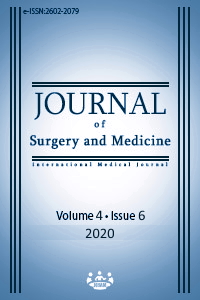Can C-reactive protein to albumin ratio be used as a predictor of amputation development in acute lower extremity ischemia?
Keywords:
Inflammation, Amputation, Embolectomy, Lower extremityAbstract
Aim: Acute lower limb ischemia is a cardiovascular emergency that occurs due to embolic and thrombotic causes. Inflammatory biomarkers obtained from routine blood parameters have been used in the diagnosis and progression of many cardiovascular diseases. In this study, we aimed to reveal the predictive value of C reactive protein to albumin ratio (CAR) in predicting limb loss, which is a significantly morbid result of thromboembolectomy.
Methods: Patients who were admitted to our clinic with acute lower extremity ischemia between March 15, 2015-March 15, 2018 and who underwent thromboembolectomy were included in this retrospective cohort study. The patients in which no extremity amputation was performed after the surgery were included in Group 1 and those in which amputation was performed in the early post-operative period (in-hospital) were included in Group 2. Multivariate logistic regression analysis was utilized to predict parameters supporting amputation in patients with lower extremity thromboembolism.
Results: There were 207 patients in Group 1 and 32 in Group 2. Amputation was performed above the knee in 5 patients (15.6%), below the knee in 23 patients (71.8%) and below the ankle in 4 patients (12.5%) in Group 2. The mean age of patients in Groups 1 and 2 were 58.7 (9.8) years and 68.3 (10.3) years, respectively (P<0.001). In the regression analysis, advanced age (OR: 1.045, CI 95%: 1.004-2.144, P=0.011), CAR (OR: 1.679, CI 95%: 1.224-3.794, P=0.005) and hospital admission time (OR: 1.054, CI 95%: 1.010-1.458, P=0.022) were determined as independent predictors for amputation.
Conclusion: The CAR value obtained from routine blood parameters obtained before the procedure may be a good predictor of amputation risk.
Downloads
References
Vemulapalli S, Patel MR, Jones WS. Limb ischemia: cardiovascular diagnosis and management from head to toe. Curr Cardiol Rep. 2015;17:611.
Aldağ M, Öztekin A, Bademci MŞ, Kocaaslan C, Denli Yalvaç EŞ, Aydın E. Surgical results of acute thromboembolic limb ischemia in octogenarians. Damar Cer Derg. 2018;27(3):111-6.
Akgül E, Engin M, Özyazıcıoğlu AF. Effects of mean platelet volume and platelet counts on peripheral biodegradable stent restenosis. J Surg Med. 2019;3(9):663-5.
Kaya BB, Özbilgin N. Effect of cardiac rehabilitation on mortality related inflammatory markers. J Surg Med. 2019;3(8):588-92.
Moon AR, Choi DH, Jahng SY, Kim BB, Seo HJ, Kim SH, et al. High-sensitivity C-reactive protein and mean platelet volume as predictive values after percutaneous coronary intervention for longterm clinical outcomes: a comparable and additive study. Blood Coagul Fibrinolysis. 2016; 271:70–6.
Melander O, Newton-Cheh C, Almgren P, Hedblad B, Berglund G, Engström G, et al. Novel and conventional biomarkers for prediction of incident cardiovascular events in the community. JAMA. 2009;302:49–57.
Arques S. Human serum albumin in cardiovascular diseases. Eur J Intern Med. 2018 Jun;52:8-12.
Duman H, Cinier G, Bakırcı EM, Duman H, Simsek Z, Hamur H, et al. Relationship between C-reactive protein to albumin ratio and thrombus burden in patients with acute coronary syndrome. Clin Appl Thromb Hemost. 2019;25:1076029618824418.
Cınar T, Çagdas M, Rencuzogulları I, Karakoyun S, Karabag Y, Yesin M, et al. Prognostic efficacy of C-reactive protein/albumin ratio in ST elevation myocardial infarction. Scand Cardiovasc J. 2019;53:83–90.
Ueberrueck T, Marusch F, Schmidt H, Gastinger I. Risk factors and management of arterial emboli of the upper and lower extremities. J Cardiovasc Surg. 2007;48:181–6.
Davi G and Patrono C. Platelet activation and atherothrombosis. N Engl J Med. 2007;357:2482–94.
Mallika V, Goswami B, Rajappa M. Atherosclerosis pathophysiology and the role of novel risk factors: a clinicobiochemical perspective. Angiology. 2007;58:513–22.
Khera A, De Lemos JA, Peshock RM, Lo HS, Staneg HG, Murphy SA, et al. Relationship between C-reactive protein and subclinical atherosclerosis: the Dallas Heart Study. Circulation. 2006;113(1):38-43.
Pant S, Deshmukh A, Gurumurthy GS, Pothineni NV, Watts TE, Romeo F, et al. Inflammation and atherosclerosis—revisited. J Cardiovasc Pharmacol Ther. 2013;19(2):170-8.
Bisoendial RJ, Boekholdt SM, Vergeer M, Stroes ESG, Kastelein JJP. C-reactive protein is a mediator of cardiovascular disease. Eur Heart J. 2010;31(17):2087-91.
Murat SN, Kurtul A, Yarlioglues M. Impact of serum albumin levels on contrast-induced acute kidney injury in patients with acute coronary syndromes treated with percutaneous coronary intervention. Angiology. 2015;66(8):732-37.
Schalk BW, Visser M, Bremmer MA, Penninx BW, Bouter LM, Deeg DJ. Change of serum albumin and risk of cardiovascular disease and all-cause mortality: Longitudinal Aging Study Amsterdam. Am J Epidemiol. 2006;164(10):969-77.
Kurtul A, Murat SN, Yarlioglues M, Duran M, Ocek AH, Koseoglu C, et al. Usefulness of serum albumin concentration to predict high coronary SYNTAX score and in-hospital mortality in patients with acute coronary syndrome. Angiology. 2016;67:34-40.
Joles JA, Willekes-Koolschijn N, Koomans HA. Hypoalbuminemia causes high blood viscosity by increasing red cell lysophosphatidylcholine. Kidney Int. 1997;52:761-70.
Mikhailidis D, Ganotakis E. Plasma albumin and platelet function: relevance to atherogenesis and thrombosis. Platelets. 1996;7:125-37.
Karabag Y, Cagdas M, Rencuzogulları I, Karakoyun S, Artac I, Ilis D, et al. Usefulness of The C-Reactive Protein/Albumin Ratio for Predicting No-Reflow in ST-elevation myocardial infarction treated with primary percutaneous coronary intervention. Eur J Clin Invest. 2018;48(6):e12928.
Cagdas M, Rencuzogulları I, Karakoyun S, Karabag Y, Yesin M, Artac I, et al. Assessment of Relationship Between C-Reactive Protein to Albumin Ratio and Coronary Artery Disease Severity in Patients With Acute Coronary Syndrome. Angiology. 2019;70(4):361‐8.
Fairclough E, Cairns E, Hamilton J, Kelly C. Evaluation of a modified early warning system for acute medical admissions and comparison with C-reactive protein/albumin ratio as a predictor of patient outcome. Clin Med (Lond). 2009;9(1):30-3.
Saskin H, Ozcan KS, Duzyol C, Baris O, Kocogulları UC. Are inflammatory parameters predictors of amputation in acute arterial occlusions? Vascular. 2017;25(2):170‐7.
Kubat E, Erol G, Akyol FB, Karabacak K, Kadan M, Doğancı S, et al. Comparison of embolectomy outcomes for acute lower limb ischemia between patients aged ≥80 years and <80 years. Turk J Vasc Surg. 2020;29(2):84-9.
Downloads
- 555 987
Published
Issue
Section
How to Cite
License
Copyright (c) 2020 Burak Erdolu, Mesut Engin
This work is licensed under a Creative Commons Attribution-NonCommercial-NoDerivatives 4.0 International License.
















